When snow fell on the 'Ring
Author
- Lorenzo Baer
Date
- February 14, 2025
Related articles
- 1968 German GP - The class of the field, by Mattijs Diepraam/Felix Muelas
- 1970 Eifelrennen - When Rindt became a Ringmeister, by Lorenzo Baer
- Jochen Rindt - Fearless until the end, by Mattijs Diepraam
- Nürburgring - Lords of the 'Ring, by Robert Blinkhorn
Who?Jochen Rindt What?Roy Winkelmann Racing Brabham-Cosworth BT23 Where?Nürburgring Südschleife When?XXX Internationales ADAC Eifelrennen (April 23, 1967) |
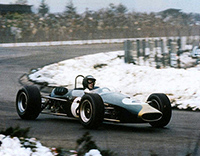 |
Why?
Like any sport, motorsport is susceptible to internal and external factors. The preparation of cars, teams and drivers, together with the organisation of the place where the race is to be contested, are elements that can be minimally controlled, as it is only up to those involved the responsibility of generating results matching the expectations previously stipulated.
However, some elements of this intricate pyramid, which is called 'organisation', are always subject to unpredictability, surprises and upheavals. Certainly, one of the factors that scares the organisers the most is the weather, which completely changes the entire planning of a well-prepared weekend. Although climate forecasts can give an idea of the general picture that can be expected, they are by no means exact sciences, being subject to last minute changes; These moments demonstrate the strength of nature, which continues to govern a large part of human activities.
And motorsport is one of the sports in which weather conditions most impact the conduct of activities. Rain or fog can change the scenario of a race, reversing advantages, giving chances to other characters, and promoting memorable moments. This set of variables is what gives a vivid colourful tone to the history of motorsports.
Although intense heat, rain, fog and wind are the main weather factors associated with interference in the races, other meteorological conditions have already manifested themselves during motorsport events; and one of them deserves special attention: snow.
Despite being rarely associated with current single-seater motorsport, snow has played an interesting role throughout the history of this type of automotive discipline: in 1977, during the Brands Hatch Christmas Meeting, a blizzard suddenly covered the British circuit. The event, which was scheduled to have Formula Libre and Formula Ford races, had to be cancelled due to the thick layer of snow that covered the track.
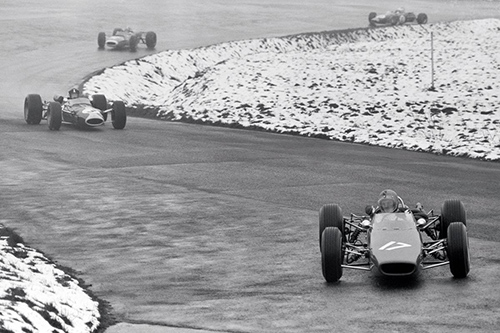
The snow was still present on the Südschleife when F2 began its show in front of the German crowd. (credits unknown)
Another well-documented case was that of the 1975 Shellsport F5000 Easter event at Oulton Park, in which a snowstorm, the night before the race, covered the circuit in a beautiful blanket of white. Luckily, the layer of snow did not have time to settle, and, in the hours preceding the race, much of the material that covered the circuit had been pushed to the sides of the track, providing conditions for the race to take place.
However, the best-known episodes in which snow became a main character in a race were certainly the 1933 Pau GP and the 1973 BRDC International Trophy. In the first case, the famous French circuit was completely covered by the white substance, with cars and drivers having to race in almost glacial temperatures. In the second, the British race became one of the most legendary in F1, despite being a non-championship race.
Although little known and talked about, the 1967 Eifelrennen should also join this select list of races that had snowflakes as an omnipresent companion. Despite being held on the Südschleife (and not on the dreaded Nordschleife), this edition of the legendary German race deserves the title of having been, to date, the only major race held at the Nürburgring under snowy conditions. Furthermore, the entry list, full of well-known names from the 1960s motorsport, leaves no doubt about the importance of the event in the context of the time.
Among the ups and downs of the circuit in the heart of the Eifel Mountains, one of the great forgotten moments of motorsport from the sixties can be found. For many, the XXX Internationales ADAC Eifelrennen can be considered just another picturesque event in the history of Formula 2. However, this race was much more than this simplistic approach can demonstrate, being one of the most magical moments in motorsport of the sixties. One that categorically affirmed the courage and skill of that generation of drivers, who left their mark on motorsports.
A change is gonna come...
The 1967 European Formula 2 season presented great new features compared to previous years. The most notable was undoubtedly the increase in the cars' power, due to the new regulations that came into force at the beginning of 1967. The maximum engine capacity had been increased from 1000cc to 1600cc, which would allow a complete reformulation of the category. Such a change became more and more urgent with each new year of the motorsport calendar that passed, as the Formula 2 regulations at the time were still based on reminiscences of the Formula Junior days.
As the category had been created at the end of 1950, it was to be expected that any legacy left by Formula Junior had long surpassed its expiration date, due to the new knowledge obtained in the technological and mechanical engineering fields. Thus, the time had finally come for the venerable Ford 105 MAE, Cosworth SCA and DKW 1000 to give way to a new generation of devices, much more developed, efficient and refined.
The Cosworth FVA engines were the immediate answer for most teams looking for new powerplants for their cars, being the most powerful and reliable in this new phase of F2. Together with a new generation of chassis, developed by the major manufacturers in the segment (Brabham, Lotus, Lola and Matra), these machines quickly demonstrated that the change was a wise decision, which would guarantee the sustainability of the category for the next few years.
Another major change promoted by the FIA for the 1967 European Formula 2 Championship (the official F2 championship of the time) was the prohibition that graduated drivers could gain points in the general classification of the category. The entity assumed that this would help F2 to finally achieve the objective it was due to, of being the last step before a driver reached Formula 1. It must be considered that until the end of the 1960s Formula 2 was still a 'playground' for F1 drivers who competed in the category's races in search of the good prizes offered by the events, combining it with a moment to improve their skills in a very competitive, but more relaxed, environment.
Even though this decision in no way prohibited the participation of F1 or WSC drivers in F2 races, the news dropped like a bombshell on the organising committees of Formula 2 races. This is because many circuits that had a Formula 2 race as their main annual motorsport event feared that such a measure would remove the big international names that regularly competed in the category – there was no longer the greater incentive of an annual title, with graduated drivers now confined to fighting for individual victories throughout the year.
The psychological terror was so great that the Fédération Française du Sport Automobile (FFSA) decided to create its own Formula 2 race calendar, mixing the new engine regulations with the old driver regulations. Therefore, at the same time as the European F2 championship, the Trophées de France would take place, a hybrid between Formula 2 (in relation to the new car specs and allowing semi-works teams) and Formula 1 (being open also to official teams and drivers).
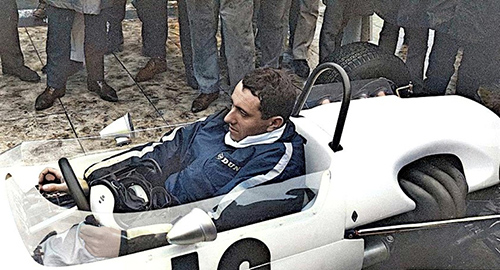
Gerhard Mitter was another of the German representatives in the 1967 Eifelrennen. Driving his own Brabham, the driver expected to face competition from the various works and semi-privateers present on the grid. (credits Harry Michelbach, colourised by the author)
However, at least in the first years of the new regulations, this fear proved nothing more than mere speculation – it would still take a while for the FIA to finally be able to separate Formula 2 from drivers from other categories. 1967 was to prove this, with more than 90% of the drivers who competed in at least one F1 event of that year also racing in Formula 2.
With this new look, Formula 2 officially kicked off in March 1967, with two races sanctioned by the British RAC, in Snetterton (I Guards '100') and Silverstone (XXII BARC '200'). After these rounds, two other non-championship races had been contested: the first leg of the Trophées de France (at the very traditional Pau GP, which was in its 27th edition in 1967) and a race promoted by the Royal Automobile Club of Catalonia (with Montjuïc being the stage for the II Gran Premio de Barcelona).
Jochen Rindt had so far demonstrated that he was the driver to beat in 1967 in Formula 2. With the exception of the race in Spain (where Jim Clark had surpassed the Austrian by a measly 1 second), Rindt had won all the other rounds until the moment. The driver had created an intense bond with his new car in F2, leaving behind the old Brabham BT18 and replacing it with the newest machine from Roy Winkelmann Racing: the Brabham BT23.
The Rindt-Brabham combination in the category had soon won its admirers, as well as the respect of most of its opponents. Except for Alan Rees (Rindt's teammate at the Roy Winkelmann team), Denny Hulme, Graham Hill and Jim Clark, the rest of the field could do little to offer a resistance to the Austrian in this first part of the championship.
Rindt's performance in Pau is perhaps the best case to summarise how the Austrian driver found himself with the new car. On the small and cramped French circuit, Jochen Rindt had taken victory after almost putting at least one lap on top of all his opponents. Hulme was the only driver to escape the fate of being lapped, finishing second (and it was a close call!).
After these first four events, all eyes were on Germany and the challenge of the Eifelrennen, the next stop in Formula 2. Expectations were high, as this would certainly be the most technically difficult race of the year, where drivers and machines were pushed to the limit on the southern part of the Nürburgring circuit. It is not surprising that once again a good number of drivers signed up for the race, promoting that traditional pot-pourri of machines that were Eifelrennen's trademark.
Cosworth, Cosworth, Cosworth... and Apfelbeck!
By the end of the registration period, a few days before the start of official activities on the German circuit, 28 drivers had signed up for the race, representing nine different brands: Brabham (8), Matra (4), Lola (4), Lotus (3), Cooper (3), Protos (2), McLaren (2), Alexis (1) and Martini (1).
As mentioned in the previous chapter, the ones with the best chances to win the race were the Brabhams, especially those from the Roy Winkelmann Racing team. Although the Brabham BT18 proved to be a superb F2 car in 1966 (only having to sustain occasional battles with factory-backed Matras and Lotuses), a natural revision of the model was necessary so that it could fit into the new regulations, which would come into force in 1967; and also for Brabham to continue as the leader in the F2 car manufacturer segment.
The result of this process was the emergence of the Brabham BT23, one of the most emblematic and superb cars in the history of Formula 2. Despite carrying some similarities with its predecessor (such as the four-wheel braking system and a steel tubular spaceframe chassis), much of the mechanical system of the car had been scratch made, transforming the already competitive machine into an almost unbeatable vehicle.
The first big difference was in the engine. In 1966, most Brabhams were powered either by the 996cc Honda RA300E – reserved only for the works team, generating a maximum output of 150hp – or by the Cosworth SCA, which were generally used by satellite and private teams (with an output of 140hp from 997cc). However, for 1967, there were no other engine alternatives other than the Cosworths FVA, with 1598cc and 218hp.
The cars became substantially more powerful, which required greater rigidity and reliability of the entire gearing system. To achieve this, another major mechanical modification had been implemented, with the substitution of the old four-speed gearbox for a new Hewland FT200 five-speed gearbox. This update allowed cars to make the most of the power of the new engine, without excessive wear on vehicle parts. As a result of these and other modifications, the BT23 was 10kg heavier than the BT18. But this was also something that contributed positively to the new vehicle, as the extra weight helped with the vehicle's traction and stability.
Rindt made the most of the new machine in the first rounds of the championship, achieving victories at Snetterton, Silverstone and Pau. Furthermore, the driver was confident about the possibility of another victory, partly due to the driver's excellent record on the Südschleife (which included a victory in the 1966 Eifelrennen). Alan Rees, who was the Austrian's Formula 2 teammate, was also optimistic, as he had done very well in the races leading up to the contest in Germany, with two third places (Pau and Snetterton), a second place (Silverstone), and a fourth place (Montjuïc).
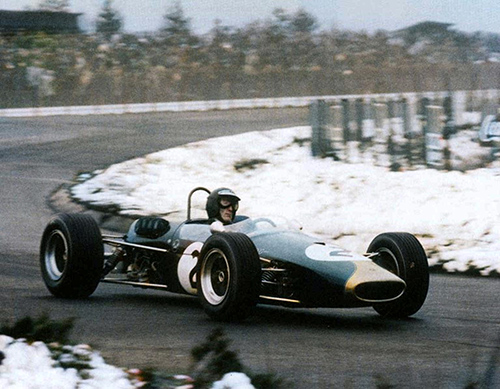
Jochen Rindt would be the name of the 1967 Eifelrennen, driving the brand new Brabham BT23. (credits unknown, colourised by the author)
The other team that would take the new BT23s to Germany was the Brabham Formula 1 team, which would race under their actual company name of Motor Racing Developments (thus circumventing the system of prohibiting registration of official teams in F2). Needing no introduction, Jack Brabham would lead his own team on the challenging German circuit, having recruited his compatriot (and also seasoned racing driver) Frank Gardner as a teammate.
Another great team that had sent a representation for the 1967 Eifelrennen was Matra Sports, which had surprised positively in 1966. The French manufacturer, which had focused most of its resources that year on F3, had decided to take another step, aiming the development of a new vehicle for F2. While it was not ready, the team wanted to learn as much as possible about the category, using some of the old F2/F3 Matras as testbeds for new technologies that would be implemented in the future.
Because of this, the MS5 underwent a major revitalisation process, which in addition to replacing the original suspension assembly, also included the change of the SCA engine for an FVA. The French team's official driver pairing was made up of the experienced Jean-Pierre Beltoise and Johnny Servoz-Gavin, the latter winner of the 1966 French F3 championship.
In addition to them, the satellite teams Tyrrell Racing Organisation and Ford France S.A. would each line up another Matra: the first, with Belgian Jacky Ickx, who had a great appearance in Pau, beating the two works Matras and finishing in fifth place, the second, which had strong financial support from the Ford subsidiary in France, would count on the services of the charismatic and skilled Jo Schlesser.
Lotus had also committed to the race in the Eifel mountains, sending three cars to Germany, which would be driven by Jim Clark, Graham Hill and Jackie Oliver. The first two would race with the new Lotus 48, developed especially for the new 1967 F2 regulations, while Oliver would have to settle for an old, updated Lotus 41B.
The 48 model was born with great expectations, as it was the newest product of the team of designers managed by Colin Chapman. The Lotus 48 incorporated several features present in the British manufacturer's most recent models, hoping that the sum of all this knowledge would create a vehicle that could fight on equal terms with the Brabhams.
For example, the monocoque chassis was derived from that used in the Lotus 42 (Indy) and 43 (Formula 1); the suspension set was an improved copy of that present in the Lotus 33, while a small part of the rear section of the car was reused from the Lotus 41B. In conjunction with the new Cosworth FVA engine and a ZF gearbox, this mixture made for a reasonably competitive car, especially in the hands of experienced drivers. The potential of the vehicle was confirmed in Montjuïc, when Clark, in another of his notable performances, managed to snatch a resounding victory, holding off the momentum of Jochen Rindt and Denny Hulme. Hill had also had his big moment in F2 in 1967, with victory slipping through his fingers in the I Guards '100' Trophy.
Meanwhile, Jackie Oliver was the 'ugly duckling' of the Lotus team for the Eifelrennen. The driver would race with the 41B model used by the team in the 1966 F2 season. The car had undergone a swift update process, with the main changes being the strengthening of the chassis to accommodate a new FVA engine. What's more, Oliver would race under the Lotus Components Ltd umbrella, while Hill and Clark would race under the Team Lotus banner.
Although there is no clear distinction between the two teams, it is impossible not to notice that one was seen as the main one, while the other was the secondary one in this story. It was enough to see that Clark and Hill's cars were painted in the English team's traditional racing colours (green and yellow) while Oliver's car was almost completely painted white, with just a green central stripe.
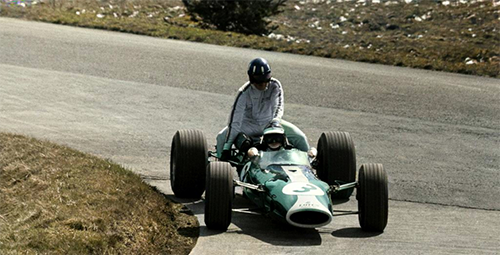
One of the most curious and fun moments of the 1967 Eifelrennen was the ride that Clark had to give to Hill after his accident during the qualifying session. (credits McKlein, colourised by the author)
McLaren would also have its share of participation in the history of the 1967 Eifelrennen. After the disappointing performance of the McLaren M2B in the 1966 F1 season, Bruce had decided to take a step back, seeking to gain experience (and funds) in lower categories. The McLaren M4A emerged as a response to this repositioning, being the brand's first dedicated lower-formula vehicle.
Initially produced in two units (M4A/1 and M4A/2), the first McLaren F2 weighed 421kg and was also equipped with a Cosworth FVA engine. Chassis 1 belonged to Bruce himself, who participated in the F2 races registered by Bruce McLaren Motor Racing Ltd. However, chassis 2, which would be driven by Piers Courage, was sold directly to John Coombs Racing, replacing the Matra-BRM MS5 used by the team in 1966.
The big difference between the #1 and #2 chassis lay in the mechanical part: while Piers Courage's car was equipped with a Hewland HD5 gearbox, Bruce's was built with an FT200 from the same manufacturer. The FT models were developments of the HD and, despite being 2kg heavier, were more precise and reliable than their predecessors. This basically meant that Bruce had on his hands a more 'modern' (technologically speaking) car than the Courage – despite both being M4As.
The last major highlight of the 1967 Eifelrennen was Lola, which had two representatives racing with its chassis. The first was the manufacturer's factory team, called Lola Racing Ltd., which included John Surtees and Chris Irwin on its roster. The other team that would also use British chassis was BMW, which would be represented by Jo Siffert and Hubert Hahne.
As in the case of Lotus, Lola had created its project for 1967 based on previous vehicles produced by the company. The monocoque construction was a clear continuation of the lineage of the Lola T60/61, built for Formula 2 in 1965, while the fuel tank frame was very similar to that used by the team in the T90 (built for the USAC/Indy).
However, everything else about the car was basically designed from scratch; starting from the suspension system, which was made now by double wishbones and outboard spring/damper units. The rear suspension was also conventional with a reversed bottom wishbone, single top links and radius rods. The engine compartment was also another major issue in the project, as the car would have to accommodate both the standard FVA engine, chosen by the official Lola team, and the peculiar Apfelbeck, selected by BMW.
Although Lola tried to maintain both teams with 'official' status, it was difficult to do so under race conditions. Lola Racing Ltd. was basically a personal investment by John Surtees, having his own interests and goals on stake – and which, frequently, clashed with those of BMW. This became clear when Surtees (in the later part of the 1967 F2 season) preferred to use cars equipped with FVA engines over those equipped with BMW units (for competitive reasons).
The heart of the problem was the lack of confidence that BMW's 225hp Apfelbeck engine inspired in drivers. The German team's audacious choice to not become a hostage to the Cosworths would take a few years to pay off and, until then, a wide range of problems would plague the mechanics and drivers of the BMW F2 team. Even though the Apfelbeck and Lola chassis combination wasn't the best on the grid, it was what the drivers had in hand to face the rest of their rivals on the Südschleife track.
The surprise was up to Surtees himself, who for contractual reasons with Lola and the German organisers, would race with a T100 equipped with the BMW-Apfelbeck engine (but entered by Lola Racing Ltd. itself). This left his teammate, Chris Irwin, as the only FVA-powered Lola representative in the grid.
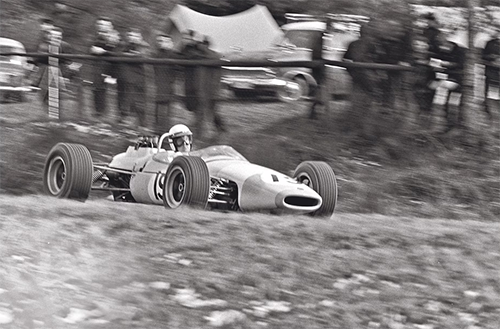
Brian Redman aboard his Brabham BT16. The photo was probably taken between the Bränkekopf and Aschenschlag section, one of the fastest on the track. (credits Hans Peter Seufert)
Despite all the attention being focused on the big players, other small teams sent interesting names to compete in the thirtieth edition of the traditional German race. Bob Gerard/Cooper Racing had registered a strong line-up for the dispute: Trevor Taylor (Cooper T82 – who would not race in the race), Peter Gethin (Cooper T82) and Mike Beckwith (Cooper T84); Meanwhile, Brian Redman would be the sole representative of David Bridges Motor Sports, driving a Brabham BT16 equipped with a 1498cc Cosworth SCB engine. These were joined by a handful of other drivers, who would race for other smaller teams or privateers in the 1967 Eifelrennen.
Snowy nights and cold days on the Nürburgring
With the exception of the German representatives in the race, who were already on the outskirts of the Nürburgring circuit, the majority of drivers and teams arrived at the location on Wednesday (19), quickly beginning to assemble the structure that would ensure the good functionality of the machines during the contest. Temperatures were already quite low, which caused some concern regarding the performance of the vehicles in these conditions.
This combined with the inherent characteristics of the Südschleife circuit. Despite not being as famous as its 'big brother', the track had a similar level of difficulty to the Nordschleife. The famous Südkehre drop, the first turn after the start, was known for the demands it placed on the entire suspension system of the cars; the fast section between Aschenschlag and Müllenbach was another point of attention for the drivers, as the high speed achieved by the vehicles, combined with the small width of the track in this section, generated an extremely dangerous combination; in addition to Betonkehre, another demanding curve for the cars, and which was essential to be well-executed, since doing the bend right could meant more accumulated speed in the track's finish/start straight. In the end, there were 7,747 meters of ascents and descents through the forests around the Nürburg Castle, which challenged without distinction the talent of all pilots involved in the race.
On Thursday, some free practice sessions were allowed at the venue, as the race calendar for the weekend included not only F2 races, but also German Formula Vee and other motorcycling events. So, it was not a surprise that the categories would fight for any slight gap in the schedule – especially considering that there were few opportunities during the year for training in the southern section of the Nürburgring.
However, it was only the following day that the first major events of the thirtieth edition of the Eifelrennen began to unfold. After an extremely cold night, in which temperatures dropped below zero in the region, the circuit was covered by a reasonable layer of snow, which prevented any movement of vehicles on the track. Although the snow itself was not a surprise in the region, even in April, the conditions in which the meteorological event occurred were strange - given that just over a week before, the thermometres in the area registered more than 20ºC. So, when the first snowflakes started to fall on the night of 20/21, it was a shock to drivers and organisers.
Great efforts were made throughout the day to clear the track for the first part of the F2 race qualifying, and, for a brief moment, the German inspectors were successful in the task. For just over half an hour, the drivers managed to do a few laps around the circuit, before conditions worsened again and the session was postponed once more. In this short period of activity on Friday, few drivers tried to go faster in the atrocious conditions present; and those who tried, well, weren't so lucky.
Robin Widdows, for example. Practicing at race pace, the British driver lost control of the car and collided with the track's protective fence, right in front of the Nürburgring pits. German Willy Martini was another who had problems, after a cylinder broke inside his car's engine during a fast lap.
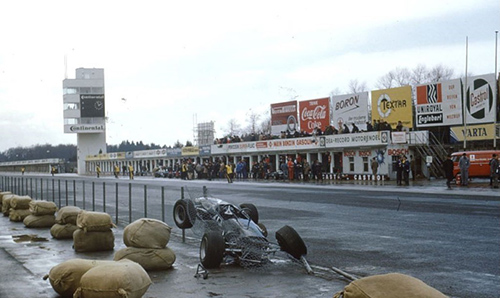
Robin Widdows had a small accident during practice at the Eifelrennen. Luckily, the track's protective fence saved the driver and his car from further damage. (credits Werner Ulrich)
Although the problem was terminal, causing the driver to withdraw from the race, Martini deserves his distinguished mention: he was the only German driver registered in the Eifelrennen who would race with a car totally made in Germany (since BMW only used a domestically manufactured engine, while the Lola chassis was manufactured in England). Little is known about Martini's car, with the exception that it was equipped with a 160hp BMW 1600 engine, which had a tubular frame and was built over a modified BMW 700 chassis.
After these accidents and problems forced the suspension of activities again, the organisers, together with ADAC, decided to finally call off the day's training. This attitude meant that the drivers would only have Saturday's qualifying session as an opportunity to guarantee themselves a place on the grid.
While the discussion about the cancellation or postponement of Friday's training session was developing, another piece of news was taking over the Nürburgring paddock. Sources linked to BMW leaked information that the Munich-based team was seriously considering the possibility of withdrawing its entries from the race, due to the poor performance of the cars in the previous races that the team had contested; despite the promising showing of the BMW cars in Friday's short practice session, in which Surtees and Siffert were among the fastest of the day.
According to the available information, BMW F2 would make such a decision based on two premises: the first was that the manufacturer would like to improve the car's reliability before it returned to the race tracks. The second, related to more passionate reasons, was that the team did not want to embarrass themselves in their own country, with the brand and the German audience itself. Although this story took shape at the end of the day, at night, Munich's final decision reached the press: the Lola-BMWs would indeed race in the XXX Eifelrennen.
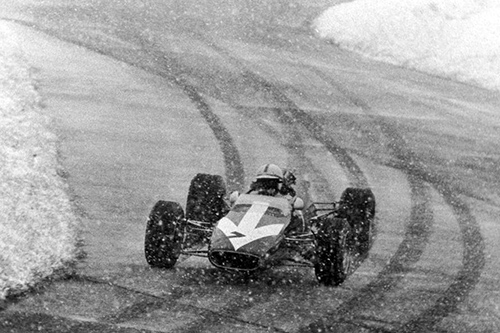
The final part of Friday's free practice saw some of the most atrocious conditions ever seen at an F2 event. Here, John Surtees makes his way through the snow on his final lap of the session. (credits Flickr)
Saturday the 22nd was another freezing day on the circuit in the heart of the Eifel mountains. Despite this, the day was clear, with the track finally ready to host official races. Even so, conditions were still challenging, with intense wind gusts and certain spots still covered in ice and snow. Because of this and to improve the condition of the floor surface for F2 practice, an event for motorcycles up to 50cc and another for Formula Vee opened the day's activities on the track.
It was only in mid-afternoon that the Lotuses, Matras and Brabhams were able to resonate again on the Südschleife. Jim Clark and Jochen Rindt monopolised Saturday's practice, with both exchanging fastest laps in succession. Clark's teammate Graham Hill could also have participated in this fight for first place if he hadn't collided with Eric Offenstadt's Protos 16 on his second timed lap.
The curious scene of the day was Clark himself giving Hill a ride to the pits, in the Lotus 48, after the accident. Despite no longer being able to set times that day (managing to set only the 18th time), Hill would participate in the race the following day, in the team's back-up car.
John Surtees also continued to perform well in Saturday's practice. The driver had chosen to save his Lola-BMW for race day, using one of the vehicles equipped with a Cosworth FVA engine in qualifying. The choice proved to be the right one, as the Englishman managed to set third best time of the day, with 2.52.9. On the other hand, the works Lola-BMWs were only 10th (Hubert Hahne) and 12th (Jo Siffert) in the overall classification.
But even all Surtees' effort would not be enough to defeat Clark and Rindt, who fought a duel throughout the qualifying session. Although the Brabham proved to be a much more balanced car, the Scot's ability to master his Lotus seemed to offset any advantage Rindt might have had. In the end, Jim Clark emerged triumphant from the duel, having reached the mark of 2.49.6, the absolute record on the Südschleife. However, Rindt wasn't far behind, setting a time just four tenths of a second slower than the Scot.
The natural light was already dissipating over the Nürburgring track when the last cars returned to the pits. It was the end of the qualifying session; and now, it was up to the teams to prepare as best as possible for the next day's race.
Sunday had finally arrived and with it, once again, the snow, which had become an almost omnipresent companion throughout the 1967 edition of the Eifelrennen. Luckily, this time, the snowfall during the night was less inclement than on previous days, and an efficient track cleaning service had already sweeped the most critical areas of the circuit. Motorcycle and sidecar events opened the day at the Nürburgring, before the F2 cars were finally allowed to take up their starting positions on the dummy grid.
30 laps would be held around the circuit in the Eifel mountains, with 21 cars officially lining up for the race. The first two rows of the starting grid were composed as follows: starting in the lead, Jim Clark (Lotus 48), followed by Jochen Rindt (Brabham BT23) and John Surtees (Lola T100). Just behind them were J.P. Beltoise (Matra MS5) and Jacky Ickx (Matra MS5). It is worth remembering that Surtees would use the Lola T100 equipped with a BMW engine in the race – and although the complete change of cars between the qualifying session and the real race seems absurd nowadays, it was indeed allowed by the F2 regulations in 1967.
Despite the freezing cold and wind, 180,000 people watched the flag drop. Clark held the lead for just a few metres, with Rindt taking first place before the Südkehre. The Scot resigned himself to being behind the Austrian, being a constant threat in the Brabham's rear mirror. Right behind, were Surtees, Beltoise and Ickx, who promoted a frank and interesting duel for the crowd in the first lap.
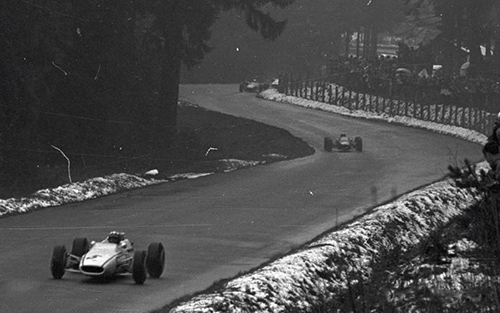
As the race continued, track conditions improved substantially, much to the relief of the drivers. (credits H.J. Roegler)
The one who was positively surprising in the race was Piers Courage, who, in just over three laps, climbed from the 13th place to a position within the top-10. As surprising as it may seem, it was only on the seventh lap that the first retirement of the race occurred – Mike Beckwith's Cooper T84, which at that time was in 20th position, had a head gasket failure, forcing the driver to abandon the race.
Further ahead, the situation remained the same: Rindt in front, followed by Clark. However, the distance between them had already become more elastic, due to problems with the Scotsman's ZF gearbox. Despite his efforts, all Clark could do was try to keep the gap at a reasonable distance, holding firmly to the second spot and hoping that Rindt would make a mistake in the coming laps. The Scot also hoped that, at least, his dying car would make it to the end of the race.
But Clark's ambitions ended abruptly on lap 11, when another problem, this one involving the engine's fuel injection system, caused catastrophic damage to the engine. It was the end of the race for the flying Scotsman.
That left Jochen Rindt in an undisputed first position, with John Surtees and Jacky Ickx already far behind. Hubert Hahne had an excellent recovery race, battling with Piers Courage for fourth spot. Behind them, another interesting dispute was developing, with German Gerhard Mitter in a Brabham BT23 and Kiwi Bruce McLaren in the M4A, competing head-to-head for sixth place.
In both cases, the Germans prevailed: Hahne managed to overtake Courage before the 20-lap mark, holding the young British driver's momentum throughout the rest of the race. In Mitter's case, Bruce gave in to the pressure, letting the German, who was faster, take sixth place - a position that Mitter would hold until the last lap when, trying not to be lapped by Rindt, he spun and crashed in the Scharfer Kopf, at a speed exceeding 190kph. The accident caused terminal damage to the car, with Mitter being classified in the eighth spot (losing positions to Bruce McLaren and Chris Irwin).
Another one with problems in the final moments of the race was Jo Siffert: even though the driver wasn't having a fabulous day, Siffert held a solid position within the ten best drivers in the race, until lap 25. In a rare mistake by the Swiss driver, the BMW left the track and collided with some bushes surrounding the track. Although the impact was not severe, it was enough for one of the front suspension mechanisms to break, making repairs beyond possible in the short time remaining.
While almost all drivers experienced a certain amount of misadventure, Rindt circulated calmly around the track – neither the cold, nor the snow, nor the atrocious conditions of the Südschleife circuit seemed to affect the Austrian driver's impeccable performance. Because of this, at the end of the 30 laps, Rindt had no trouble crossing the finish line first, with a total time of 1.35.46.4. Just 15 seconds later, it was Surtees' turn to go through the track's finishing straight for the last time – and completing the podium came Jacky Ickx in the best classified Matra of the day.
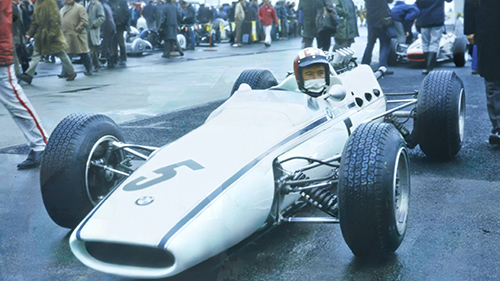
Hubert Hahne would have a surprisingly good race on the Südschleife, managing to take the Lola-BMW very close to the podium. (credits Revs Institute)
This was Jochen Rindt's second triumph at the Eifelrennen, having won the 1966 edition at the same Südschleife. More important than that, however, was that Rindt reinforced his image of being the strongest driver of the year in F2, collecting his fourth triumph in the five races contested so far. The victory was also a testament to the quality of the new Brabham, which had withstood without slowing down during some of the most extreme track conditions ever seen on European circuits. If it wasn't the drivers or even the weather, what would stop Rindt in F2 in 1967?
Why to read me?
Over the following months, Jochen Rindt began to face more qualified and better prepared opposition in F2, which mainly materialised in the form of the Lola Racing Ltd. (equipped with the FVA-powered Lola) and Team Lotus (with an improved version of the Lotus 48). However, this did not prevent the Austrian from winning the XXXIII Grand Prix of Reims and the XV Grand Prix of Rouen-les-Essarts (rounds valid for the Trophées de France), the II Flugplatzrennen Tulln-Langenlebarn and the VII Guards Trophy (rounds of the F2 European Championship), in addition to the non-championship I Hämeenlinnaloppet, held at the Ahvenisto circuit, Finland.
Just looking at his performance in 1967, it would be impossible not to recognise Rindt as one of the greats of F2, the category in which the Austrian had produced some of his finest performances in motorsport. Even though it may seem minor compared to his F1 title in 1970 and his victories in prototypes and touring cars during his active years, it is always important to reinforce the fact that Rindt, in most of the occasions which he ran in F2, competed in races not against unknown or lesser-known names; but actually, versus many of those who were also his rivals in F1 or WSC.
The fact that graduated drivers were banned from scoring points in F2 from 1967 onwards was a fact that never bothered Rindt much. It is worth noting that even with the change in regulations the Austrian would continue to drive in the category on a regular basis until almost his death, splitting his efforts between it and the other automobile disciplines in which the driver was involved.
Due to the unexpected interruption of the driver's career in 1970, Rindt was unable to see the future developments of F2 which, from that decade onwards, focused much more on being a training/grassroots environment than of the simple role of a sub-F1 category, finally gaining its own identity. However, the legacy of Formula 2 in the sixties will never be forgotten – a time when Clark, Hill, Surtees and so many other stars came down from the highest rungs of motorsport to return to their origins.
And it was certainly on that weekend in April 1967 that the category gave one of its greatest spectacles: the scene of snow falling on the mythical Nürburgring, with cars going at speeds around 200kph and Jochen Rindt leading, will certainly be something to be remembered in the picturesque and colou rful history of Formula 2.
